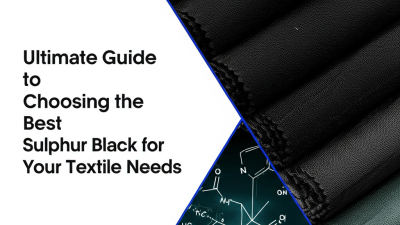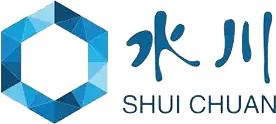In the dynamic world of textile manufacturing, the choice of dye has significant implications for both product quality and market competitiveness. Sulphur Black, known for its deep, rich hues and excellent wash fastness, plays a crucial role in dyeing processes across various fabrics. According to a recent industry analysis, the global dye market is projected to reach approximately $15 billion by 2025, with Sulphur Black anticipated to capture a notable share due to its cost-effectiveness and environmental benefits. As manufacturers increasingly prioritize sustainable practices, the demand for Sulphur Black and similar dyes is expected to rise, prompting a need for comprehensive guidance in selecting the right grades. Understanding the specific requirements of your textile applications can not only enhance product performance but also strengthen your position in an increasingly competitive marketplace.

Sulphur black, a widely used dye in the textile industry, offers several advantages that make it an essential choice for manufacturers. One of its primary benefits is its strong colorfastness, which ensures that garments retain their deep black hue even after multiple washes. According to a report by Textiles and Clothing Research, textile products dyed with sulphur black exhibit an impressive colorfastness rating of up to 4.5 on the grey scale, significantly outperforming many alternatives in terms of durability and longevity.
Furthermore, sulphur black is known for its cost-effectiveness and eco-friendliness. The dyeing process requires less water and energy compared to other dyeing methods, which aligns with the industry's growing emphasis on sustainability. According to the Sustainable Apparel Coalition, switching to sulphur black can reduce water consumption in the dyeing process by approximately 30%, promoting a more responsible approach to textile manufacturing. Additionally, with advancements in formulation, many modern sulphur blacks are being developed to have reduced toxicity, thus minimizing the environmental impact while maintaining high quality. This makes sulphur black an attractive option for brands aiming to implement sustainable practices without compromising on aesthetic appeal.
When selecting sulphur black for your textile needs, understanding its key characteristics is essential. Sulphur black is known for its rich, deep color and excellent lightfastness, making it a popular choice among fabric manufacturers. Its ability to absorb dye evenly across various fabric types helps ensure consistent quality in the final product. Additionally, sulphur black’s resistance to fading enhances the longevity of the dyed textiles, which is a significant consideration for both producers and consumers.
**Tip:** Always conduct a preliminary test to evaluate how sulphur black behaves with your specific fabric type. This can help identify any potential issues with colorfastness or dye absorption before full-scale production begins.
Another important aspect of sulphur black is its environmental profile. While it offers excellent performance qualities, it is crucial to source sulphur black from suppliers who prioritize sustainable and eco-friendly manufacturing practices. This not only aligns with modern consumers' preferences but also contributes to reducing the overall environmental impact of the textile industry.
**Tip:** Look for suppliers who provide certifications for their sourcing and manufacturing processes, ensuring that you are using a product that is both effective and environmentally responsible.
When it comes to dyeing textiles, cost-effectiveness is often a key consideration for manufacturers. Sulphur black dye emerges as a strong contender thanks to its comparatively lower cost and versatility. Unlike synthetic dyes that often require more complex procedures and additional chemicals, sulphur black can be applied using simpler methods, significantly reducing labor and processing costs. Moreover, its high affinity for cellulose fibers makes it particularly suitable for cotton, which is one of the most commonly used materials in the textile industry.
In a comparative analysis, sulphur black outshines other traditional dye types, such as reactive and direct dyes, especially in bulk processing scenarios. While reactive dyes may offer vibrant colors and ease of use, they typically involve higher costs and a more intricate application process. Direct dyes also fall short in terms of wash fastness and overall durability. The longevity and resistance properties of sulphur black make it a preferred option for businesses seeking not only cost efficiency but also high-performance results in their textile applications. This makes it an attractive choice for companies looking to balance quality and affordability effectively.
The use of Sulphur Black in textile production is increasingly scrutinized through the lens of sustainability. As the textile industry continues to grapple with its environmental impact, Sulphur Black emerges as a relatively eco-friendly dye alternative compared to conventional synthetic dyes. According to a report by the Textile Exchange, the average textile dyeing process can consume up to 100 liters of water per kilogram of fabric dyed. However, Sulphur Black requires significantly less water due to its affinity for cotton fibers, highlighting its advantage in water conservation efforts.
Moreover, Sulphur Black's production process generates fewer harmful byproducts, aligning with the industry's shift towards green practices. A study published in the Journal of Cleaner Production found that Sulphur Black can be synthesized using non-toxic ingredients and with minimal energy consumption, further enhancing its sustainability profile.
Organizations like the Global Organic Textile Standard (GOTS) emphasize the importance of using dyes that reduce environmental damage, positioning Sulphur Black as a favorable option for brands aiming to enhance their environmental credentials. As the demand for sustainable textiles grows, opting for environmentally-friendly dye solutions like Sulphur Black could be pivotal in driving the industry towards a greener future.
As the textile industry evolves, so do the innovations in sulphur black dyes, which are gaining increasing attention for their versatility and sustainability. One of the most notable trends is the development of eco-friendly sulphur black formulations that reduce environmental impact while maintaining high performance. These innovations are driven by a growing demand for sustainable practices in textile production, pushing manufacturers to explore alternative processing techniques and raw materials that align with eco-conscious consumer preferences.
Another emerging trend lies in the use of advanced technologies such as digital printing combined with sulphur black dyes. This approach allows for more precise coloration and intricate designs while minimizing waste associated with traditional dyeing processes. Moreover, the integration of smart textiles with sulphur black dye applications opens new avenues for functional fabrics, enabling features such as temperature regulation and moisture control. As these innovations continue to reshape the landscape of textile applications, manufacturers are presented with exciting opportunities to enhance product offerings while adhering to sustainability standards.
